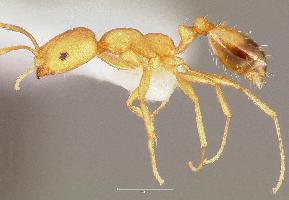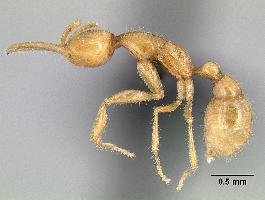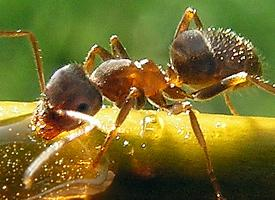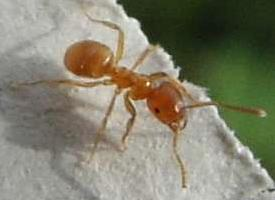
Váhy a míry
| Délka | 2 mm |
|---|
Stav ohrožení
| Neohrožen |
Popis zvířete
The Pharaoh ant, scientifically named Monomorium pharaonis, is a small yet highly invasive species of ant that has spread to virtually every corner of the globe. Originating from Africa, this species has adapted to live in close quarters with humans and can now be found in many urban and suburban environments, thriving particularly well indoors. The adaptability and resilience of the Pharaoh ant make it an intriguing subject of study, as well as a significant pest in many areas.Adult Pharaoh ants are easily recognizable by their light yellow to red bodies, with a darker abdomen that is almost black in color. They are quite small, typically measuring between 1.5 to 2 millimeters in length. Despite their diminutive size, these ants are known for their complex social structure and behaviors. Pharaoh ants live in colonies that can contain thousands to hundreds of thousands of individuals, including workers, males, and queens. The colonies are polygynous, meaning they have multiple queens, which is one reason why they can proliferate so rapidly and effectively.
One of the most fascinating aspects of Pharaoh ants is their method of colony propagation, known as "budding" or "satelliting." When a colony becomes too large or is disturbed, a group of ants, including workers, brood (eggs, larvae, and pupae), and one or more queens, will break off from the main colony to establish a new colony elsewhere. This ability to fragment and disperse makes Pharaoh ants particularly difficult to control once they infest an area.
Pharaoh ants are omnivorous, feeding on a wide range of substances. Their diet includes proteins, sweets, fats, and other insects. Inside human dwellings, they are often found foraging for food in kitchens and pantries, where they can contaminate food sources and spread diseases. Their preference for warm, humid environments often leads them to nest in wall voids, under floors, or even within appliance housings, making them an invisible nuisance.
The reproductive cycle of Pharaoh ants is another key to their success as a species. Queens can lay hundreds of eggs in their lifetime, and under optimal conditions, the development from egg to adult can take as little as 38 days. This rapid lifecycle allows Pharaoh ant populations to grow at an astonishing rate, especially since they face few natural predators within human habitats.
Controlling and eradicating Pharaoh ants can be exceptionally challenging due to their nesting and foraging behavior, as well as their ability to spread quickly through budding. Traditional ant baits and insecticides often prove ineffective against Pharaoh ants, as they can simply avoid treated areas or split their colonies to evade extermination efforts. Integrated pest management strategies that focus on sanitation, exclusion, and the use of slow-acting baits to target the entire colony are typically recommended for dealing with Pharaoh ant infestations.
In conclusion, the Pharaoh ant is a small but formidable insect, capable of thriving in a wide range of environments and posing significant challenges for pest control. Their complex social structure, rapid reproductive rate, and adaptability have allowed them to spread across the globe, making them a persistent and ubiquitous pest in human environments. Understanding the biology and behavior of Pharaoh ants is crucial for developing effective strategies to manage and control their populations.
Podobná zvířata
Nové fotografie zvířat
Top 10 zvířat
- Elephant hawk moth (Deilephila elpenor)
- Common house mosquito (Culex pipiens)
- Wasp spider (Argiope bruennichi)
- Common cockchafer (Melolontha melolontha)
- Fruit fly (Drosophila melanogaster)
- Australian box jelly (Chironex fleckeri)
- Colossal squid (Mesonychoteuthis hamiltoni)
- Moustached guenon (Cercopithecus cephus)
- Diana monkey (Cercopithecus diana)
- Bee hummingbird (Mellisuga helenae)


